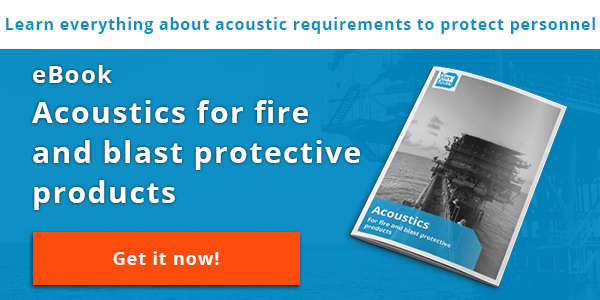The importance of acoustics in creating a healthy working environment


It may not be the first that comes to mind when thinking of safety in on- and offshore work environments, but acoustic control is a significant part in the engineering process of blast and fire protective products. Over the past years, the importance of acoustics in creating a healthy working environment has led to a rise in strict requirements to protect personnel against high levels of noise.
Ever since the official declaration of noise (or unwanted noise) being an environmental pollutant in 1972 during the International Conference for the Environment, employers are expected to safeguard the health of employees in terms of hearing. Especially in the oil & gas industry, there is a range of complex sound issues which need to be addressed and resolved to ensure this.
The NORSOK standard on acoustic
NORSOK, being one of the leading standards for on- and offshore structures operating in the oil & gas marketing, provides a lot of insight and information for contractors on acoustics and noise control. They define the responsibilities for acoustics, noise and vibration control and its documentation during the concept, engineering, fabrication, commissioning and early production phases. Further information for guidelines on noise control is provided by the standards ISO 11688 (all parts), ISO 14163 and ISO 15667.
The (NORSOK) aim is to limit noise levels and attain satisfactory sound insulation and acoustic conditions throughout the areas of e.g. accommodation, utility, drilling and production.
According to NORSOK, a good acoustic environment:
- reduces the risk of permanent hearing damage to an acceptable level and prevent accident risks and other health hazards;
- ensures that warning signals and emergency messages are clearly audible;
- allows adequate speech, telephone and radio communication, and audible oral perception;
- makes a reasonable level of conversational privacy possible;
- maintains working efficiency and proficiency of personnel performing designated tasks;
- provides an acceptable sleeping and recreational environment in accommodation area (LQs).
Organizational responsibilities
The best ways to achieve, evaluate and control noise and acoustic control is by equipping the engineering team with at least one experienced noise control engineer. This person should be responsible for all activities regarding noise control. These activities include:
- the establishment of specific noise control requirements;
- noise evaluations and calculation;
- documentation and results.
The purpose of overall noise control is to ensure that the design of the installation and all fire protective products that are installed, promote and increase the quality of the working environment during the operational phase.
Acoustic protection is an important focal point. Download our eBook for more insight and information on acoustics for fire and blast productive products.






